Hanfu are the historical clothing of the Han Chinese, here categorized by clothing style.
Informal wear

Types include tops and bottoms, long skirt, and one-piece robes that wrap around the body once or several times (shenyi).
Zhongyi (中衣), which is usually the inner garment much like a Western T-shirt and pants, can be wear along in casual.
The typical set of informal wear consists of two or three layers. The first layer is mostly zhongyi (中衣). The next layer is the main layer which is mostly closed at the front. There can be an optional third layer which is often an overcoat called a zhaoshan which is open at the front.
For footwear, white socks and black cloth shoes (with white soles) are the norm. But in the past, shoes may have a front face panel attached to the tip of the shoes.
| Romanization | Hanzi | Definition | Description | Period | Images |
|---|---|---|---|---|---|
| Zhōngyī | 中衣 |  | |||
| Bàofù | 抱腹 | Han[1] | |||
| Dùdōu | 肚兜,
兜肚, or 兜兜 |
Qing |  | ||
| Héhuān Jīn | 合欢襟 | Yuan dynasty[2] | |||
| Liǎngdāng | 两当 | It is an underwear which is made up of a square-shaped back and front panels.[1] | A form of hufu. It was introduced in the Central Plains by the nomads of China.[2] | Wei and Jin[1] | |
| Mǒxiōng | 抹胸 | Song[1] | |||
| Xièyī | 亵衣 | Pre-Han[1] | |||
| Xīnyī | 心衣 | Han[1] | |||
| Zhǔyāo | 主腰 | Ming[1] |
| Romanization | Hanzi | Definition | Description | Period | Images | ||
|---|---|---|---|---|---|---|---|
| Zhíjū | 直裾 | Straight lapelled, full body garment. | Pre-Qin – Han |  |
 |
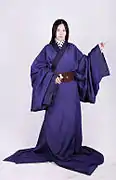 | |
.jpg.webp) |
.jpg.webp) |
 | |||||
| Qūjū | 曲裾 | Diagonal body wrapped, full body garment. | Pre-Qin – Han |  |
 | ||
| Kùzhě | 裤褶 | Clothing with trousers for riding or military style clothing.[3][4] | A short coat with trousers. | Pre-Qin - Ming. |  |
 | |
| Páofú | 袍服 | ||||||
| Yèsāpáo | 曳撒 or
一撒 |
A form of kuzhe.[3][4] | Ming; Modern |  |
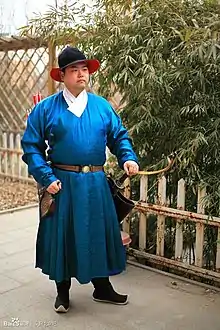 |
||
| Zhì sūn fú or yisefu | 质孙服 or 一色服 | "robe of one colour" | Introduced in Yuan; later became a uniform for the military officials Ming. | Yuan – Ming | |||
| Rúqún | 襦裙 | "Jacket and skirt" | An upper garment covered by a separate skirt.
A common clothing for women. |
Pre-Qin – Ming; Modern | .jpg.webp) |
 |
|
 |
 |
 | |||||
| Ǎoqún/ | 袄裙/
衫裙 |
A short coat with a long skirt underneath. A common clothing for women. | Han – Ming; Modern | 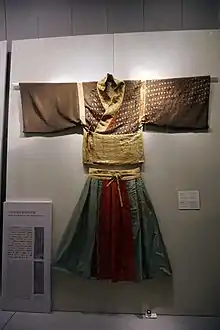 |
|||
 |
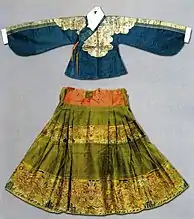 |
 | |||||
 |
 |
||||||
| Zhíduō | 直裰 | Straight robe. | Similar to zhiju but with vents at sides and cuffed sleeves. | Tang – Ming |  |
 |
 |
| Modern | 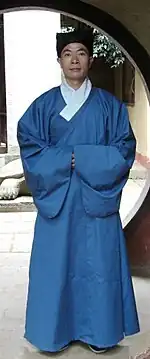 |
||||||
| Dàopáo | 道袍 | Taoist robe. | Worn by Taoist priests and normal scholars. | Song – Ming; Modern |  |
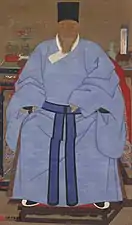 |
 |
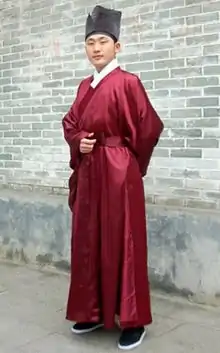 |
|||||||
| Shuǐtiányī | 水田衣 | Ming-Qing |  |
||||
| Bǎijiāyī | 百家衣 | Liu Song – Modern | 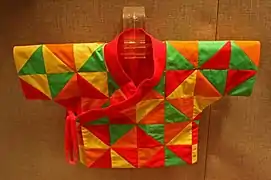 |
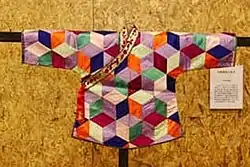 |
|||
Semi-formal wear
Generally, this form of wear is suitable for meeting guests or going to meetings and other special cultural days. This form of dress is often worn by the nobility or the upper-class as they are often expensive pieces of clothing, usually made of silks and damasks. The coat sleeves are often deeper than the shenyi to create a more voluminous appearance.
A piece of ancient Chinese clothing can be "made semi-formal" by the addition of the following appropriate items:
- Chang (裳): a pleated skirt
- Bixi (蔽膝): a cloth attached from the waist, covering front of legs.
- Zhaoshan (罩衫): long open fronted coat
| Romanization | Hanzi | Definition | Period | Images | |||
|---|---|---|---|---|---|---|---|
| Banbi | 半臂 | A half-sleeved waistcoat. | Tang – Ming | 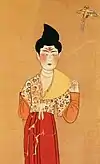 |
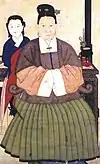 |
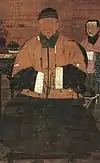 |
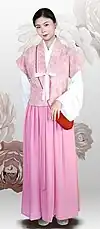 |
| Bijia | 比甲 | An open-sided vest. | Ming | 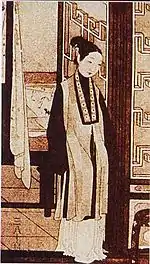 |
|||
| Beizi
or |
褙子or
披风 |
Large loose outer coat with loose and long sleeves | Song – Ming |  |
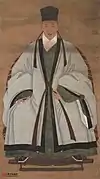 |
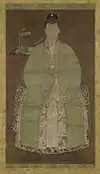 |
|
Formal wear
In addition to informal and semi-formal wear, there is a form of dress that is worn only at confucian rituals, important sacrifices, religious activities or by special people who are entitled to wear them (such as officials and emperors).
The most formal dress civilians can wear is the xuanduan (sometimes called yuanduan 元端),[7][8] which consists of a black or dark blue top garment that runs to the knees with long sleeve (often with white piping), a bottom red chang, a red bixi (which can have a motif and/or be edged in black), an optional white belt with two white streamers hanging from the side or slightly to the front called peishou (佩綬), and a long black guan. Additionally, wearers may carry a long jade gui (圭) or wooden hu (笏) tablet (used when greeting royalty). This form of dress is mostly used in sacrificial ceremonies such as Ji Tian (祭天) and Ji Zu (祭祖), etc., but is also appropriate for state occasions. The xuanduan is basically a simplified version of full court dress of the officials and the nobility.
| Romanization | Hanzi | Definition | Period | Images | |||
|---|---|---|---|---|---|---|---|
| Xuanduan/ | 玄端/
元端 |
Literally "dark solemn", a very formal dark robe.[7][9] | Pre-Qin - Song |  |
|||
| Shenyi | 深衣 | A long full body garment. | Song - Ming | 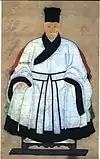 |
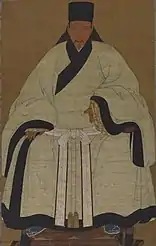 |
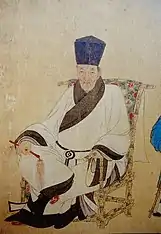 |
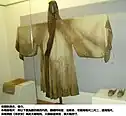 |
| Yuanlingshan/
Panlingpao |
圓領衫/盤領袍 | Closed round-collared robe. Mostly used for official occasions. | Sui – Ming |  |
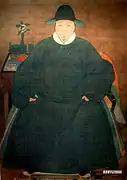 |
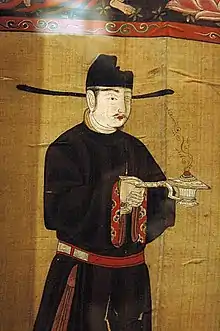 |
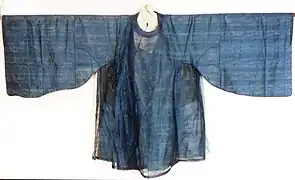 |
| Lanshan | 襴衫 | Closed round-collared robe with black edges. Mostly used for academical dress; worn by scholars and students (生員) taking the imperial examination. | Tang – Ming | 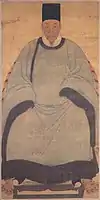 |
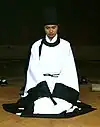 |
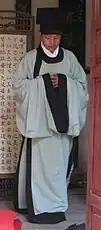 |
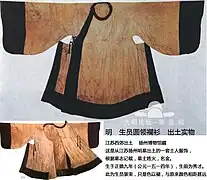 |
| Daxiushan | 大袖衫 | Large Sleeve Gown. Worn by royal women. | Five dynasties – Tang |  |
 |
 |
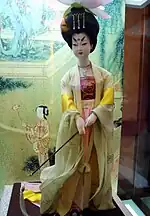 |
| Chang'ao | 長襖 | A long overcoat | Ming | 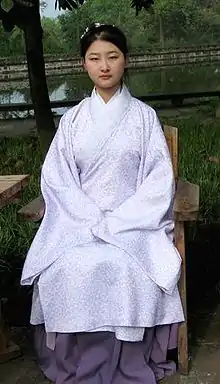 |
|||
| Zaju chuishao fu or Guiyi | 杂裾垂髾服 or 袿衣 | A formal dress worn by Elite women. | Cao Wei to Northern and Southern dynasties |  |
|||
Court dress

Court dress is the dress worn at very formal occasions and ceremonies that are in the presence of a monarch (such as an enthronement ceremony). The entire ensemble of clothing can consist of many complex layers and look very elaborate. Court dress is similar to the xuanduan in components but have additional adornments and elaborate headwear. They are often brightly colored with vermillion and blue. There are various versions of court dress that are worn for certain occasions. The practical use of court dress is now obsolete in the modern age since there is no reigning monarch in China anymore.
Those in academia or officialdom have distinctive gowns (known as changfu 常服 in court dress terms). This varies over the ages but they are typically round collared gowns closed at the front. The most distinct feature is the headgear which has 'wings' attached. Only those who passed the civil examinations are entitled to wear them, but a variation of it can be worn by ordinary scholars and laymen and even for a groom at a wedding (but with no hat).
Court dress of emperors
| Romanization | Hanzi | Definition | Period | Images | |||
|---|---|---|---|---|---|---|---|
| Longpao (龙袍) | Jifu | 吉服 | The dragon robe for special occasions. | Shang – Ming |  |
 |
 |
| Changfu | 常服 | The dragon robe for daily wear. | Tang – Qing |  |
 |
 | |
| Mianfu | 冕服 | Attire worn by emperors and crown princes. | Shang – Ming | 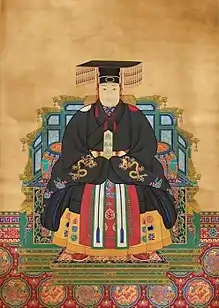 |
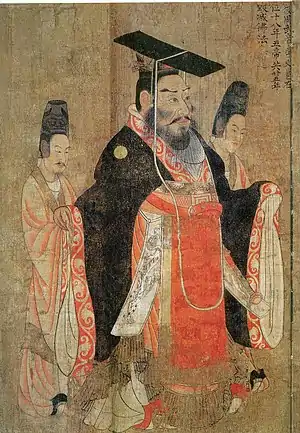 |
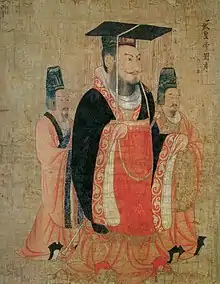 | |
| Tongtianguanfu | 通天冠服 | Tongtian, literally means "direct links with heaven".[10] Ceremonial dress. | Shang – Ming | .jpg.webp) |
|||
| Bianfu | 弁服 | Occasional court dress. Also worn by officials or the nobility. | Shang – Ming | .jpg.webp) |
|||
Court dress of officials
| Romanization | Hanzi | Definition | Period | Images | ||
|---|---|---|---|---|---|---|
| Chaofu | 朝服 | A red ceremonial court dress of emperor, officials or nobility. | Zhou – Ming | 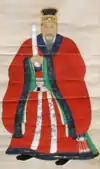 |
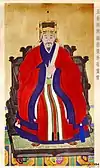 |
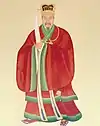 |
| Gongfu | 公服 | Formal court dress according to ranks.[11] | Tang - Ming | 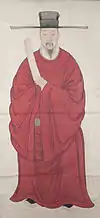 |
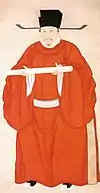 |
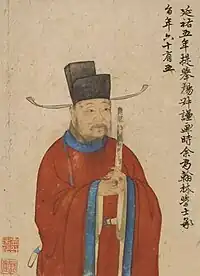 |
| Changfu | 常服 | Everyday court dress. | Song – Qing | 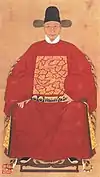 |
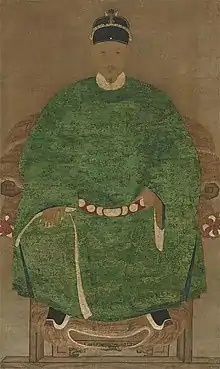 |
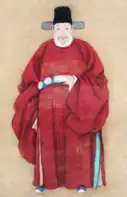 |
| Bufu | 补服 | Changfu sewn with Mandarin square. | Ming – Qing | 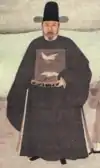 |
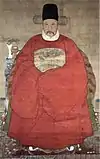 |
 |
| Zhongjingfu | 忠静服 | Retired official's bufu with same colour long cloth belt.[12] | Ming |  |
%252C_1591.png.webp) |
%252C_1591_(2).png.webp) |
| Cifu | 賜服 | Ceremonial court dress of the highest rank officials. The right to wear such dress was bestowed by emperors as a special honour. | Ming – Qing |  |
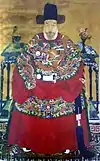 |
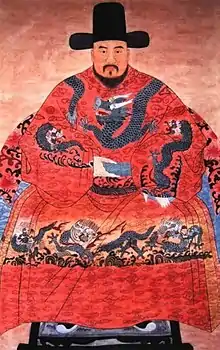 |
| Mangfu | 蟒服 | Also known as the "four-clawed dragon" robe or "python robe". It is a type of Cifu. | Ming-Qing | 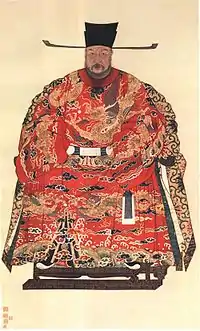 |
 |
|
| Feiyufu | 飞鱼服 | Also known as "flying fish" robe. It is a type of Cifu. | Ming | 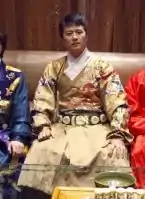 |
||
| Douniufu | 斗牛服 | Also known as "fighting bull" robe. It is a type of Cifu. | Ming | 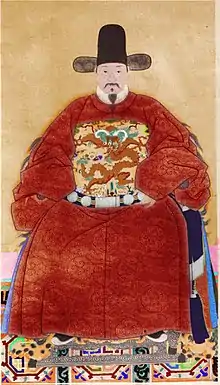 |
||
| Precedence | Rank | Robe Color | Animal on Patch
(Civil) |
Animal on Patch
(Military) |
Exemplified Positions (Not All-Inclusive) |
|---|---|---|---|---|---|
| 1st
(Highest) |
First Rank Primary
正一品 |
Red-crowned crane | Lion | Emperor's Chief Advisor 太師
Regional Commander 都督 | |
| 2nd | First Rank Secondary
從一品 |
Emperor's Assistant 少傅
Regional Executive Officer 都督同知 | |||
| 3rd | Second Rank Primary
正二品 |
Golden pheasant | Lion | Crown Prince's Teaching Assistant太子少師
Secretary of Defense 兵部尚書 | |
| 4th | Second Rank Secondary
從二品 |
Governor 布政使
Provincial Deputy Commander 都指揮同知 | |||
| 5th | Third Rank Primary
正三品 |
Peacock | Tiger | Mayor of Beijing 順天府尹
Deputy Secretary of Labor 工部侍郎 | |
| 6th | Third Rank Secondary
從三品 |
Minister of the Imperial Stud 太僕寺卿
Minister of Salt Supply 都轉鹽運使 | |||
| 7th | Fourth Rank Primary
正四品 |
Wild goose | Leopard | (Eunuch Position) Handler of the Imperial Seal 掌印太監
Minister of Foreign Affairs 鴻臚寺卿 | |
| 8th | Fourth Rank Secondary
從四品 |
Principal of the Imperial Academy 國子監祭酒
Governor's Junior Assistant 參議 | |||
| 9th | Fifth Rank Primary
正五品 |
Silver pheasant | Bear | Principal of the Imperial Medical Academy 太醫院使
Grand Secretary of the Cabinet 内閣大學士 | |
| 10th | Fifth Rank Secondary
從五品 |
Junior Scholar at the Imperial Library 翰林院侍讀學士
Deputy Manager of the Department of Justice 刑部員外郎 | |||
| 11th | Sixth Rank Primary
正六品 |
Egret | Panther | (Female Position) Manager of Royal House Records 司記
Minister of Buddhist Affairs 僧錄司善世 | |
| 12th | Sixth Rank Secondary
從六品 |
Deputy Mayor 同知
Deputy Manager of Minority Affairs 安撫司副使 | |||
| 13th | Seventh Rank Primary
正七品 |
Mandarin duck | Panther | Auditor of the Supreme Court 大理寺評事
Investigating censor 監察御史 | |
| 14th | Seventh Rank Secondary
從七品 |
Monitor of the Six Ministries 給事中
Deputy Ambassador 行人司左司副 | |||
| 15th | Eighth Rank Primary
正八品 |
Oriole | Rhinoceros | Accountant at the Department of Finance 戶部照磨
Deputy County Administrator 縣丞 | |
| 16th | Eighth Rank Secondary
從八品 |
Assistant Priest at the Ministry of Imperial Sacrifices 太常寺祀丞
Supervisor at the Ministry of Royal Food Service 光祿寺監事 | |||
| 17th | Ninth Rank Primary
正九品 |
Quail | A horse in the sea
(not seahorse) |
Chief Servant at the Ministry of Royal Theatres 教坊司奉鑾
Chief Officer at the Headquarter of Official Travels 會同館大使 | |
| 18th
(Lowest) |
Ninth Rank Secondary
從九品 |
Warden 司獄
Marshal 巡檢 | |||
Court dress for women
| Romanization | Hanzi | Definition | Period | Images | ||
|---|---|---|---|---|---|---|
| Huidi-yi | 褘翟衣 | Attire worn by empresses and crown princesses. | Zhou – Ming | 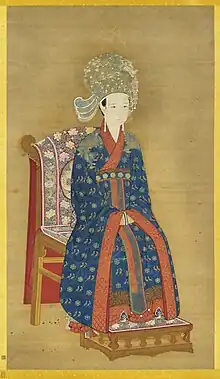 |
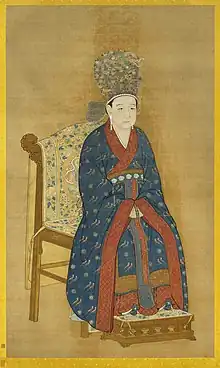 |
 |
| Dashanxiapei | 大衫霞帔 | The large gown with the radiance hanging scarf. Ceremonial court dress of empresses and mìngfu. | Song- Ming | 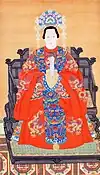 |
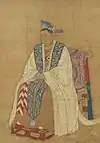 |
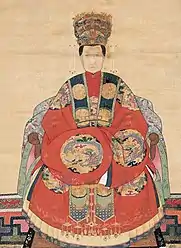 |
| Changfu | 常服 | Everyday court dress of mìngfu. | Ming | 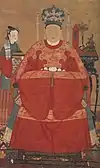 |
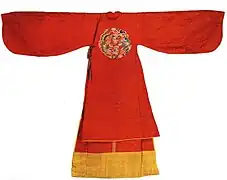 |
|
| Bufu | 补服 | Changfu sewn with Mandarin square. Ceremonial court dress of mìngfu. | Ming | 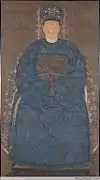 |
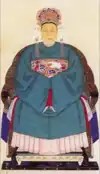 |
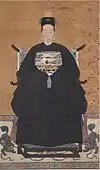 |
Cloaks
 Doupeng (斗篷), a cloak
Doupeng (斗篷), a cloak
Lower garments
| Romanization | Hanzi | Definition | Description | Period | Images | ||
|---|---|---|---|---|---|---|---|
| Chang/ Shang | 裳 | A narrow, ankle-length skirt.[13] | Shang - Zhou | ||||
| Liuxianqun | 留仙裙 | "Fairy skirt".[14] | Han | ||||
| Jianqun or Jiansequn | 间裙 or 间色裙 | Stripped skirts.[15] | It was a high waisted skirts which integrated both the techniques of the Han dynasty and foreign techniques from the Western Region.[16] In the Sixteen kingdoms, the skirt had panels of different colours; which could vary to: 6, 8, 12 regions.[16] From the Northern dynasty to the Tang dynasty, the skirt had denser multiple stripes.[16] In Tang, the stripped skirt was A-line.[17] | Wei, Jin, Northern and Southern dynasties - Tang dynasty | 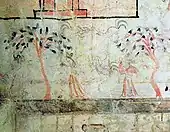 |
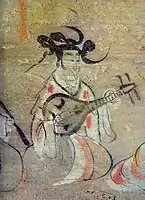 |
 |
.jpg.webp) |
 |
 | |||||
| Bainiaoqun | 百鸟裙 | "Hundred bird-feather skirt".[18] | A feather skirt worn by a princess in Mid-Tang; the skirt was made with the feathers from a hundred birds.[19] | Tang | |||
| Shiliuqun | 石榴裙 | "Pomegranate skirt" | A red skirt which was very popular.[19] | Tang | 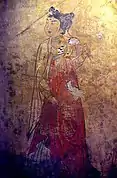 |
 |
 |
| Yujinqun | 郁金裙 | "Turmeric skirt" | A yellow skirt which was dyed with turmeric.[19] | Tang | |||
| Liangpianqun | 两片裙 | An unpleated skirt which is composed of two pieces of fabric sewn to the same waistband. The middle part of the skirt overlap and are not sewn together.[20] | Song | ||||
| Baidiequn | 百迭裙 | A one-piece pleated skirt; the top is narrow and the bottom is wide.[20] | Song | ||||
| Sanjianqun | 三裥裙 | A skirt made of 4 skirts pieces sewn together.[20] | Song | ||||
| Zhejianqun | 褶裥裙 | "Folded skirt" | Song | .jpg.webp) |
|||
| Mamianqun | 马面裙 | "Horse-face skirt".[21] | A skirt made of two-pieces of fabric sewn to the same waistband. The sides of the skirt has knife pleats whereas the back and front have flat panels.[22] | Ming-Qing |  |
 | |
.jpg.webp) |
.jpg.webp) |
||||||
| Baijianqun | 百襇裙 | "Hundred pleated skirt".[21] | Qing | ||||
| Yuehuaqun | 月華裙 | "Moonlight skirt".[21] | Made of ten pieces of fabric which was then tucked in 10 pleats; each pleats had a different colour which was light. It was a popular skirt in the early Qing dynasty.[19] | Qing | .jpg.webp) |
 |
|
| Yulinqun | 鱼鳞裙 | Lit. "fish-scale" skirt. | A skirt where pleats were joined with silk threads in order to makes creases which look like the scales of a fish.[19] The pleats were very tiny.[21] | Qing | .jpg.webp) |
||
| "Rainbow skirt".[23] | Qing |  |
|||||
| Langanqun | 襕干裙 | "Chinese ink painting skirt". | A skirt where scattered flowers pattern were printed.[19] | Qing | .jpg.webp) |
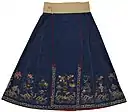 |
|
| Fengweiqun | 凤尾裙 | Lit. "Phoenix-tail skirt". | An underskirt which is decorated with long ribbons of different colours of silk, the ribbons were narrow. Different embroidery is found on in each ribbon strips. It was popular during the reign of Kangxi and Qianlong.[19] | Qing | |||
| Baizhequn | 百摺裙 | An all-around small pleated skirt.[24] | Qing - Republic | ||||
Religious clothing
Those in the religious orders wear a plain middle layer garment followed by a highly decorated cloak or coat. Taoists have a 'scarlet gown' (絳袍) which is made of a large square-shaped cloak sewn at the hem to create very long deep sleeves used in very formal rituals.[25] They are often scarlet or crimson in colour with wide edging and embroidered with intricate symbols and motifs such as the eight trigrams and the yin and yang Taiji symbol.
Buddhist have a cloak with gold lines on a scarlet background creating a brickwork pattern which is wrapped around over the left shoulder and secured at the right side of the body with cords. There may be further decorations, especially for high priests.[26]
Daoists, Buddhists and Confucians may have white stripe chevrons.
| Name | Hanzi | Definition | Description | Period | Images | |||
|---|---|---|---|---|---|---|---|---|
| Fusha
or Haiqing |
彿裟
or 海青 |
"sea-blue".[27] | Buddhist priests' full dress ceremonial robes. It is also worn by Zhenyi priests in Taiwan; it is blue in colour.[27] | |||||
|
Fayi (法衣); "ritual clothing"[28] |
Jiangyi or Jiangpao | 絳衣 or
絳袍 |
"Robe of descent",[29] or "scarlet robe".[25][30] | A square-shaped poncho-like upper outer garment; the square symbolizes the earth which is perceived as square in Chinese cosmology.[31][30][32] It has motifs such as the sun, moon, Three heavens, stars and constellations, Sacred (golden) tower and flying cranes, Wu yue, Mountain peaks and cosmic waters.[31]It is worn by high ranking taoist priests, e.g. Grandmasters.[31] It is a formal outfit worn during Taoist ceremonies.[33] | Ming- Present | 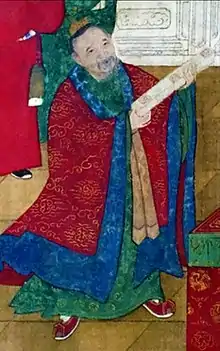 |
%252C_19th_century_(CH_18464275-2).jpg.webp) |
%252C_19th_century_(CH_18464275).jpg.webp) |
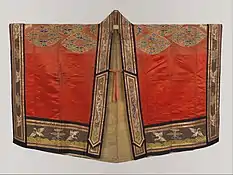 |
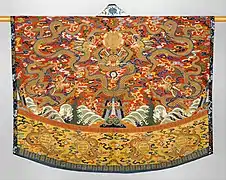 |
|||||||
| Huayi | 花衣 | "Flowery robe" | It is a ritual robe, worn under the jiangyi.[32] It is well decorated with motif, such as dragons, clouds, mountains, cranes and the seven stars Dipper.[28] It is worn by seniors and high ranking taoist priests.[28] | Unknown- Present | ||||
| Banyi | 班衣 | "Colourful robe" | It is a ritual robe; it can have embroidered borders but the clothing is typically monochrome, mostly red in colour. It is worn for during daily recitations of scriptures in a worship hall before divinities.[28] | Unknown – Present |  |
|||
| Daopao | 道袍 | "Taoist robe"
or "Robe of the Dao" |
It is worn by middle-rank Taoist priests.[34] It is red in colour and is covered with decorations, such as bagua and cranes.[27] | Unknown – Present |  |
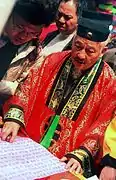 |
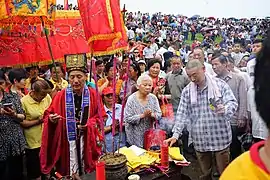 | |
| Daoyi | 道衣 | A wide-sleeved, cross-collared gown worn by Taoist priests and nuns; it is a standard type of clothing.[35] | Unknown- Present | |||||
| De luo | 得罗 | An indigo formal ritual clothing, worn by Taoism priests in the Quanzhen order; the blue colour is a symbolism for the East.[27] It is cross-collared.[32] | Unknown – Present | |||||
| Da gua | 大褂 | "Great gown"[27] | It is a common type of informal, daily clothing worn by Taoists; in present days, it is mostly narrow-sleeved and blue in colour.[32] | Unknown – Present | ||||
| Jieyi | 戒衣 | "Precept robes"[28] or "ordination robes" | It is a large sleeved, monochrome yellow-coloured, cross-collar robe with black trims.[28][32][36] | Unknown- Present | ||||
Handwear
Gloves and mitts
.jpg.webp) Han mitts, Mawangdui Tomb, Han dynasty.
Han mitts, Mawangdui Tomb, Han dynasty.
See also
References
- 1 2 3 4 5 6 7 "Secrets of Women's Underwear". www.chinadaily.com.cn. Retrieved 2022-01-10.
- 1 2 "Hanfu History of Ancient Chinese Underwear – 2022". www.newhanfu.com. 2020. Retrieved 2022-01-11.
- 1 2 Cho, Woohyun; Yi, Jaeyoon; Kim, Jinyoung (2015). "The dress of the Mongol Empire: Genealogy and diaspora of theTerlig". Acta Orientalia Academiae Scientiarum Hungaricae. 68 (3): 22–29. doi:10.1556/062.2015.68.3.2. ISSN 0001-6446.
- 1 2 Finnane, Antonia (2008). Changing clothes in China : fashion, history, nation. New York: Columbia University Press. p. 45. ISBN 978-0-231-14350-9. OCLC 84903948.
- ↑ 周锡保 (Oct 1986), 《中国古代服饰史》 (PDF) (in Chinese) (2nd ed.), 中国戏剧出版社, p. 263, retrieved May 17, 2009
- ↑ 朱和平 (July 2001), 《中国服饰史稿》 (PDF) (in Chinese) (1st ed.), 中州古籍出版社, pp. 222–223, retrieved May 20, 2009
- 1 2 Milburn, Olivia; Yan, Ying (2015). The Spring and autumn annals of Master Yan. Leiden: Brill. p. 319. ISBN 978-90-04-30966-1. OCLC 933295487.
- ↑ Xu, Zhongguo Gudai Lisu Cidian, p. 7.
- ↑ Chen, BuYun (2019), Riello, Giorgio; Rublack, Ulinka (eds.), "Wearing the Hat of Loyalty: Imperial Power and Dress Reform in Ming Dynasty China", The Right to Dress: Sumptuary Laws in a Global Perspective, c.1200–1800, Cambridge: Cambridge University Press, pp. 416–434, doi:10.1017/9781108567541.017, ISBN 978-1-108-47591-4, S2CID 165356490, retrieved 2021-02-16
- ↑ 臧, 迎春 (2003). 臧, 迎春 (ed.). 中国传统服饰. 臧迎春, 李竹润. 五洲传播出版社. ISBN 7508502795.
- ↑ Volpp, Sophie (June 2005). "The Gift of a Python Robe: The Circulation of Objects in "Jin Ping Mei"". Harvard Journal of Asiatic Studies. 65 (1): 133–158. doi:10.2307/25066765. JSTOR 25066765.
- ↑ "67". History of Ming.
忠静服仿古玄端服,色用深青,以纻丝纱罗为之。三品以上云,四品以下素,缘以蓝青,前后饰本等花样补子。深衣用玉色。素带,如古大夫之带制,青表绿缘边并里。素履,青绿绦结。白袜。
- ↑ Sullivan, Lawrence R. (2021). Historical dictionary of Chinese culture. Nancy Liu-Sullivan. Lanham, Maryland. p. 173. ISBN 978-1-5381-4604-0. OCLC 1233321993.
{{cite book}}: CS1 maint: location missing publisher (link) - ↑ Long, Wei; Lee, Eun-Young (2010-05-28). "Comparison of Aesthetics Between Han and Tang Dynasties Women Costumes". Korean Association of Human Ecology: 125–126. Archived from the original (PDF) on 2021-04-10.
- ↑ "Types and Wear Styles of Tang Dynasty Women's Clothing". www.newhanfu.com. 10 November 2020. Retrieved 2021-04-10.
- 1 2 3 "Study on Jianqun(striped skirt) in Archaeological Data from the Jin to Tang Dynasties--《Archaeology and Cultural Relics》2010年02期". en.cnki.com.cn. Retrieved 2021-04-10.
- ↑ Chen, Buyun (2019). Empire of style : silk and fashion in Tang China. Seattle: University of Washington Press. p. 84. ISBN 978-0-295-74531-2. OCLC 1101879641.
- ↑ Chen, Buyun (2019). Empire of style : silk and fashion in Tang China. Seattle: University of Washington Press. p. 52. ISBN 978-0-295-74531-2. OCLC 1101879641.
- 1 2 3 4 5 6 7 Hua, Mei; 华梅 (2004). Zhongguo fu shi (Di 1 ban ed.). Beijing: Wu zhou chuan bo chu ban she. ISBN 7-5085-0540-9. OCLC 60568032.
- 1 2 3 "Guide to Traditional Chinese Clothing – Hanfu". www.newhanfu.com. 2 November 2020. Retrieved 2021-03-12.
- 1 2 3 4 "Skirt (China), 19th century". Cooper Hewitt, Smithsonian Design Museum. Retrieved 2021-04-10.
- ↑ Bonds, Alexandra B. (2008). Beijing opera costumes : the visual communication of character and culture. Honolulu: University of Hawaiʻi Press. p. 168. ISBN 978-1-4356-6584-2. OCLC 256864936.
- ↑ Anonymous (2018-10-31). "Rainbow Skirt". Cleveland Museum of Art. Retrieved 2021-04-10.
- ↑ Styling Shanghai. Christopher Breward, Juliette MacDonald. London, UK. 2020. pp. 47–50, 54. ISBN 978-1-350-05114-0. OCLC 1029205918.
{{cite book}}: CS1 maint: location missing publisher (link) CS1 maint: others (link) - 1 2 "Daoist Headdresses and Dress – Scarlet Robe". taoism.org.hk. Archived from the original on 6 March 2008.
- ↑ "High Priest of the Shaolin Monastery". Newhanfu.
- 1 2 3 4 5 The encyclopedia of taoism. Fabrizio Pregadio. Richmond: Curzon. 2002. p. 457. ISBN 978-1-135-79634-1. OCLC 810277082.
{{cite book}}: CS1 maint: others (link) - 1 2 3 4 5 6 Herrou, Adeline (2016). A World of Their Own : Daoist Monks and Their Community in Contemporary China. St Petersburg: Three Pines Press. p. 47. ISBN 978-1-365-53752-3. OCLC 1011219060.
- ↑ "Collecting Silk · Mellon Projects". glam.uoregon.edu. Retrieved 2021-04-05.
- 1 2 Dusenberry, Mary M. (2004). Flowers, dragons and pine trees : Asian textiles in the Spencer Museum of Art. Carol Bier, Helen Foresman Spencer Museum of Art (1 ed.). New York: Hudson Hills Press. p. 136. ISBN 1-55595-238-0. OCLC 55016186.
- 1 2 3 "From the Land of the Immortals | RISD Museum". risdmuseum.org. Retrieved 2021-04-05.
- 1 2 3 4 5 "What is Taoist Clothing? – 2021". www.newhanfu.com. 2020. Retrieved 2021-04-05.
- ↑ "Daoist priest's robe 18th century". www.metmuseum.org. Retrieved 2021-04-05.
- ↑ "Daopao (Taoist priest's robe) | RISD Museum". risdmuseum.org. Retrieved 2021-04-05.
- ↑ Komjathy, Louis (2013). The Daoist tradition : an introduction. London. ISBN 978-1-4411-1669-7. OCLC 819275585.
{{cite book}}: CS1 maint: location missing publisher (link) - ↑ The encyclopedia of taoism. Fabrizio Pregadio. Richmond: Curzon. 2002. pp. 286, 457. ISBN 978-1-135-79634-1. OCLC 810277082.
{{cite book}}: CS1 maint: others (link)